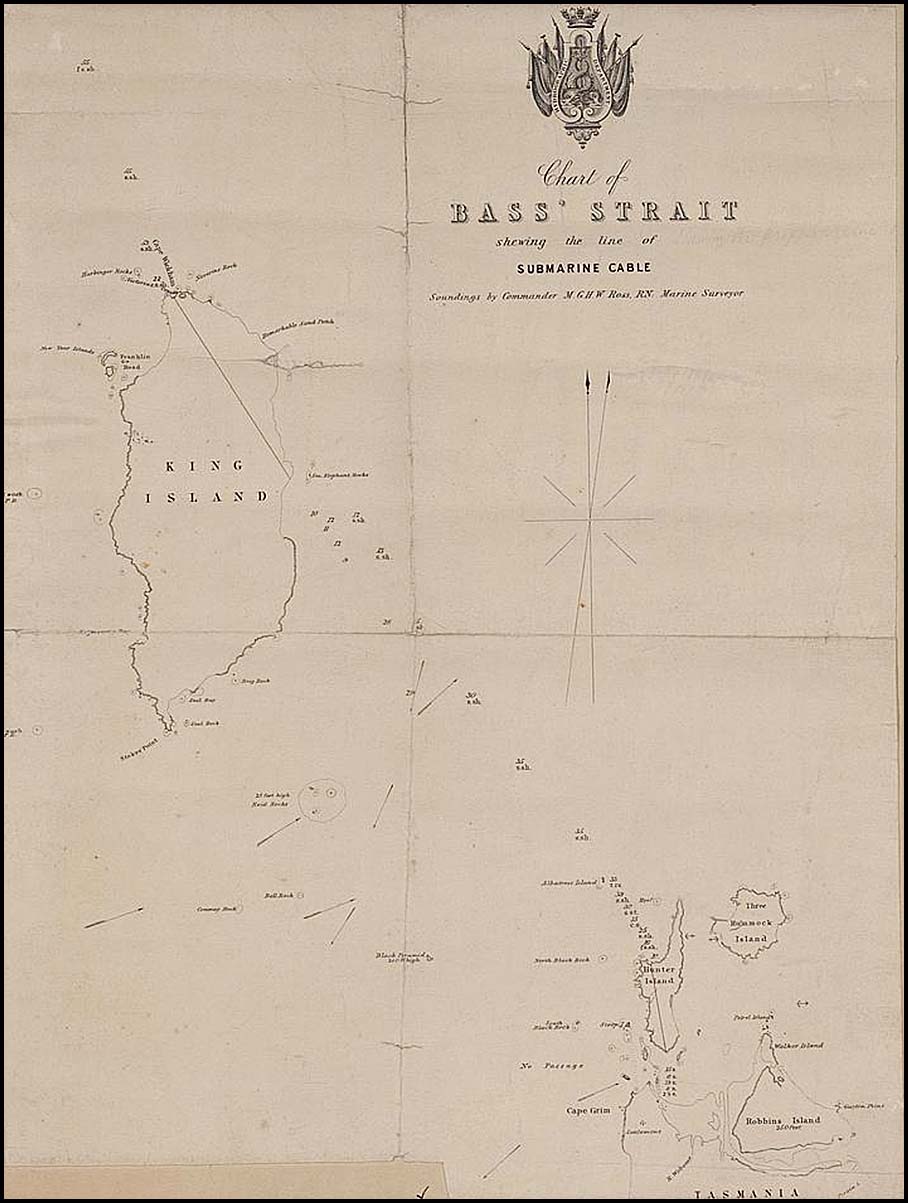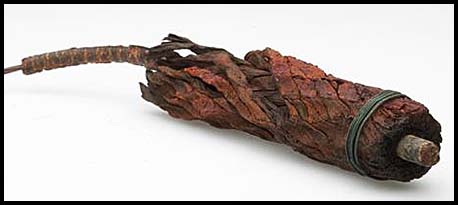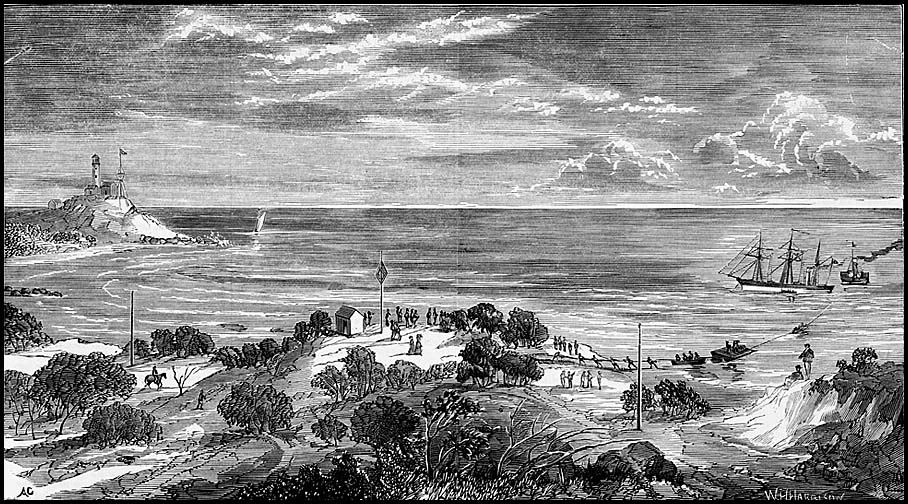The 1859 cable.
- Home, index, site details
- Australia 1901-1988
- New South Wales
- Overview of NSW
- Telegraph lines
- Telegraph Offices
- Date stamps
- Forms
- Envelopes
- Rates
- Stamps
- Queensland
- Overview of Qld
- Telegraph lines
- Telegraph offices
- Date stamps
- Forms
- Envelopes
- Rates
- Stamps
- South Australia
- Overview of SA
- Telegraph lines
- Telegraph Offices
- Date stamps
- Forms
- Envelopes
- Rates
- Stamps
- Tasmania
- Overview of Tasmania
- General developments
- Reports
- Organisation
- Telegraph lines
- Telegraph Offices
- Date stamps
- Railway lines
- Forms
- Envelopes
- Rates
- Stamps
- Overview of Tasmania
- Victoria
- Overview of Vic.
- Telegraph lines
- Telegraph offices
- Date stamps
- Forms
- Envelopes
- Rates
- Stamps
- Ephemera
- Western Australia
- Overview of WA
- Telegraph lines
- Telegraph Offices
- Date stamps
- Forms
- Envelopes
- Rates
- Stamps
Details of planning and laying the cable are summarised below:
- the cable;
- laying the cable;
- laying process complete;
- the Melbourne horse races;
- modifications.
The Official Chart.
 Surveying map used for the 1859 cable. Soundings by Commander M.G.H.W. Ross, R.N. Marine Surveyor. Source: National Library of Australia Map F244 - see http://nla.gov.au/nla.map-f244-sd-cd |
| The cable used had a stranded central conductor covered with a layer of insulation. The insulation was covered by two layers of fibrous material (probably hemp) in strands of about 5 mm diameter. The two layers were laid in opposite directions. The outer layer of fibrous material was surrounded by possibly 12 armouring wires with each wire about 6 -- 8 mm in diameter. |  Part of the 1875 cable. Source: Museum of Victoria ST 007068. |
The responsibility for actually laying the cable was assigned to The Eastern Extension Cable Company which organised the cable, the operations of the ships, the connections, etc.
The following account of the submerging of the cable was forwarded to the Launceston Examiner by Captain George Gilmore, who, as agent of the Tasmanian Government, accompanied Captain Norman in the H.M.C.S. Victoria:
BASS'S STRAITS CABLE.
To the Editor of the Launceston Examiner.
Sir: In order that the public may have some information respecting the submerging of the electric cable, I forward for publication a few remarks from a daily journal which I kept during the expedition on board H.M.C.S. Victoria.
The conduct of the master of the steamer Omeo is inexplicable, and tended to mar the success of the undertaking.
Captain Norman and the officers of the Victoria deserve the thanks of the community for the valuable assistance they afforded and their persevering efforts to carry out this important undertaking in the face of the difficulties and opposition they had to contend with.
I have the honor to be, Sir,
Your obedient servant,
George Gilmore.
Launceston, 15 August 1859.
H.M.C.S. Victoria, Port Phillip Heads.
Ed. note: it may be useful to use the map of King Island to locate some of the places mentioned below.
McGowan was immediately concerned with the lack of care exercised by those on the Omeo when laying the cable near King Island and Three Hummock Island especially between 27 and 31 July. He wrote to Mr. McNaughton while laying was still in progress:
 |
Mr.McNaughton replied as follows:
 |
The Geelong Advertiser of 24 August 1859 was one of a number of newspapers which carried a detailed description from the Argus of the laying of the cable - and indicated the possible problems which might lay ahead:
"THE SUBMERGING OF THE TASMANIAN CABLE.
H.M.C.S. Victoria returned to Hobson's Bay on Saturday evening last, from her trip with the Omeo. Also from revisiting the different stations in the Straits where the cable had been landed, with a view to discovering where the insulation was defective. It will be seen by the report taken from the log at the north part of King's Island that communication is perfect with Tasmania.
On arriving at Cape Wickham, nearly half a mile of the cable was found strewed on the beach, broken into innumerable pieces and bent and twisted into extraordinary contortions. A specimen of the cable was obtained there, and has been brought up by the Victoria and which will be found worthy of inspection, as showing the immense strain it must have borne, also the twisted knots it has formed.
Considerable delay must take place before communication with Tasmania will be opened up, as the shore end at Cape Otway will have to be examined. It is stated that it was thrown out of the boats in coils, one lying over the other. At King's Island the end is lost, and it will be necessary that it be grappled for. If not found by that means, the entire distance from Cape Otway will have to be under-run, which will be a task of great difficulty and delay.
Some inquiry will have to be held respecting the difficulties that have arisen in the matter of the laying down this cable. A full investigation is looked for by the public and is due to the officers and crew of the Victoria, and to the Omeo, her officers, the contractor, and all concerned in the work".
The cable laying was finally completed on 18 August 1859 with a whale-boat landing the cable and batteries. A land connection with Launceston was completed soon after landing. At the time, the cable was the longest submarine cable in the world at 117 miles in length. The second longest cable was that between Britain and Holland (113 miles).
 Bringing the cable ashore at Low Head in Tasmania. From a wood engraving by W. H. Harrison published in The Illustrated Australian by Ebenezer and David Syme, June 19, 1869. |
The date generally given for the opening of the cable for use by the public is 28 September 1859. Given other reports, it appears that miscellaneous "bits and pieces" still had to be completed. Certainly there was some relaying undertaken to move the cable position further to the east in parts.
Nevertheless the cable worked! And in true Australian spirit, one of the first tasks addressed was to use the cable to convey sporting results - indeed the results of the Great Champion Sweepstakes at Melbourne Race Course on 1 October 1859. That is just three days after the cable opened.
The telegraph line linked the Telegraph Branch to the Grandstand. As The Hobart Town Daily Mercury reported (p.2) on 3 October:
Through the kindness of S. W. McGowan Esq., we are enabled to lay before our readers the result of the Great Champion Sweepstakes which event came off on the Melbourne Race Course this morning. All Melbourne and the surrounding towns "turned out" on this occasion. Never, perhaps, has there been more interest manifested by the Victorians in any event than they are said to have manifested with regard to this.
During the time the Telegrams were arriving, the office at the Franklin Wharf was thronged with Citizens anxious to know the result. The excitement from first to last was very great, greater than we remember to have seen it in Tasmania for many years past.
For the record, Flying Back beat Zoe and Nutwith by several lengths in a field of 19 in the time of 5 min 57½ sec. There were two other races onthe card as well.
The Portland Guardian of 23 December 1859 reported:
"We are glad to be able to announce that the under-running and relaying so much of the cable as the altered route rendered necessary have been successfully accomplished. Both operations were difficult and dangerous and it is gratifying to learn that in neither case was the execution of the work attended by accident. Communication exists between Melbourne and King's Island and it only remains to construct a short aerial-line from the new landing-place to complete the connection between this and the other colonies".
Mr. Savage appears to have displayed considerable ability and perseverance in overcoming the difficulties by which he was surrounded; and both he and the contractors have well earned, and we believe they will receive, the cordial thanks of the Australian public. We annex two messages received from Mr. Savage, that have been courteously placed at our disposal":
Message 1: King's Island, Dec. 10, 1859.
The landing of the cable was successfully completed at 5 p.m. yesterday. I am much indebted to Captain Spence for the cordial and efficient way in which he has cooperated with me. I have not been able to land stores for land line yet but if they cannot be landed to-day, I will land them at the Yellow Rock, dismiss the steamer, and boat them round to Victoria Cove. (Signed) G. Savage.
Message 2: 12th Dec., 1859.
The weather has been very bad. Steamer not able to leave till this morning. Have landed stores at the Yellow Rock, only wait available to receive them and commence the land line. (Signed) G. Savage. Examiner.
The cable had cost the Tasmanian Government £80,000.
When Charles Todd was planning a line from Cape Jervis to Nepean Bay on Kangaroo Island in 1860, he made arrangements to purchase some of the unused Tasmanian cable.